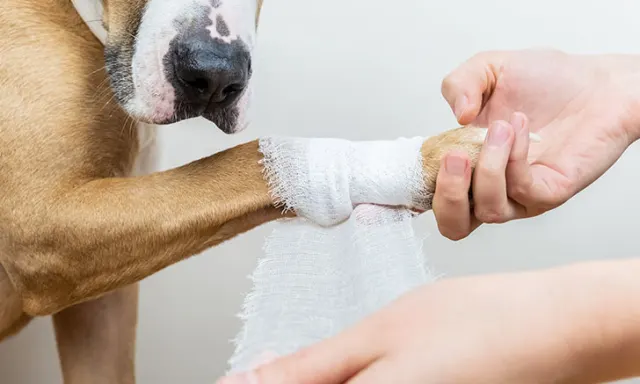Top 5 Wounds that Can Benefit from Nitric Oxide Treatment

This content was provided by Noxsano. Clinician's Brief was not involved in the creation of this content. Clinician's Brief does not inherently endorse any product or organization advertised across its properties. The appearance of an advertisement on Clinician's Brief properties is neither a guarantee nor an endorsement of the product or advertising claims. Clinician's Brief is not responsible for the content promoted in an advertisement.
Nitric oxide (NO) is an endogenous regulator of inflammation that also provides beneficial antimicrobial effects to wounds during the healing process.1 Because of these attributes, topical NO presents potential as a powerful aid in wound healing in both human and veterinary medicine.1 NO rapidly drives granulation to fill cavity wounds and cover exposed bone and tendons. NO also has properties that combat bacteria and bacterial biofilms, reducing the need for systemic antibiotics when fighting localized infections.2 In veterinary medicine, improving the speed and success of wound healing can benefit not only the patient and pet owner but also the veterinary team through increased client satisfaction and time savings.
1. Trauma, Wounds, & Burns
Abrasions, lacerations, skin tears, bites, burns, and penetrating wounds vary in severity and thus can be treated with a wide variety of treatments and techniques, from cleaning and dressing to surgical intervention. NO use is appropriate for both simple and complex wounds, eliminating the need for complex decision-making to determine a patient’s candidacy for treatment. NO rapidly drives granulation to fill in wounds, provides antimicrobial benefits that prevent the wound from stalling, and signals for re-epithelialization, all of which can help drive the wound to closure.3,4

2. Infected Wounds & Wounds At Risk for Infection
NO offers a triple threat for bacteria. As a signaling molecule, NO promotes growth and activity of immune cells.5 As an antimicrobial, it causes nitrosative and oxidative damage to DNA, proteins, and lipids to inhibit or kill target pathogens.4 NO also disrupts biofilms, which are more resistant to antimicrobials.1 By signaling for biofilm dispersal, NO exposes the bacteria as the planktonic state, making it more susceptible to antimicrobial activity, including that of NO.1 Disrupting biofilm infections allows infections to be more easily remediated while limiting the need for systemic antibiotics.6 Reducing antibiotic use can lower costs and lessen the strain on the animal’s digestive system while also contributing to good antibiotic stewardship.

3. Chronic Wounds
Chronic wounds are frequently stalled in a pathologic inflammation state and may cause persistent infection and other secondary complications.7 NO plays a critical role in the regulation of various wound-healing processes, including inflammatory response, cell proliferation, collagen formation, antimicrobial action, and angiogenesis.3,4 Research in diabetic humans has shown that use of topical NO has been shown to restart healing in these long-term stalled wounds.1
4. Equine Distal Limb Wounds
Formation of exuberant granulation tissue (EGT) or proud flesh is a common complication in equine distal limb injuries.8 Wounds healing by secondary intent are particularly susceptible to formation of EGT. Among its many roles in the wound-healing process, NO has anti-inflammatory properties9 and reduces leukocyte adhesion, which drives the wound toward healing.10 NO promotes angiogenesis and vasodilation, resulting in well-oxygenated tissue.11 NO is a naturally occurring antimicrobial and signals for macrophage polarization switch, which is a key step in the transition from the inflammatory to postinflammatory stages of wound healing.12 Topical NO can speed healing13 and thus reduce the risk for formation of proud flesh associated with slowly healing wounds.8

5. Surgically Created Wounds, Including Grafts & Flaps
Wound healing is a highly ordered process, with the aim of tissue regeneration. Incorporation of topical closures such as graft and flaps can accelerate the process, but if these surgical interventions are not properly incorporated by the newly growing tissue, they can result in tissue rejection and delayed wound healing. NO influences the intercellular communication of macrophages, fibroblasts, and keratinocytes and increases the speed of wound healing, enabling the incorporation of tissue from the graft or flap into the healing wound with less risk for rejection.14 Antimicrobial properties aid in healthy closure, particularly in cases when contamination may have been introduced.

Conclusion
NO is produced naturally throughout the wound-healing process.15 NO promotes growth and activity of immune cells and defends against pathogens.4,5 NO also controls macrophage polarization, helping wounds transition out of the inflammatory phase and into the proliferative phase, where NO drives increased blood flow, angiogenesis, proliferation, and epithelialization, resulting in rapid wound closure, reduced proud flesh, and stronger tissue.7-9,11-13 Delivering exogenous NO topically boosts what happens naturally in healthy wound healing, speeding the process and supporting the body in maintaining healthy healing.1,13 Restore by Noxsano’s Wound Pads and Gels harness the power of topical NO in an easy and cost-effective delivery system.
